

Matei Dima
Étudiant au collège Saint-Anne de Lachine
Attack on Pearl Harbor. The attack on Pearl Harbor[nb 4] was a surprise military strike conducted by the Imperial Japanese Navy against the United States naval base at Pearl Harbor, Hawaii, on the morning of December 7, 1941 (December 8 in Japan).
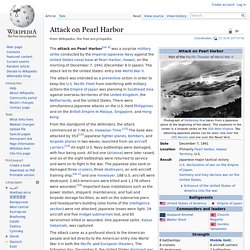
The attack led to the United States' entry into World War II. The attack was intended as a preventive action in order to keep the U.S. Pacific Fleet from interfering with military actions the Empire of Japan was planning in Southeast Asia against overseas territories of the United Kingdom, the Netherlands, and the United States. There were simultaneous Japanese attacks on the U.S. -held Philippines and on the British Empire in Malaya, Singapore, and Hong Kong.
Oklahoma City bombing. The Oklahoma City bombing was a domestic terrorist bomb attack on the Alfred P.
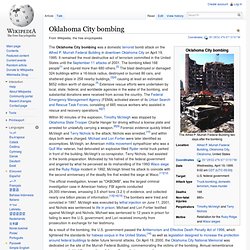
Murrah Federal Building in downtown Oklahoma City on April 19, 1995. It remained the most destructive act of terrorism committed in the United States until the September 11 attacks of 2001. The bombing killed 168 people[1] and injured more than 680 others.[2] The blast destroyed or damaged 324 buildings within a 16-block radius, destroyed or burned 86 cars, and shattered glass in 258 nearby buildings,[3][4] causing at least an estimated $652 million worth of damage.[5] Extensive rescue efforts were undertaken by local, state, federal, and worldwide agencies in the wake of the bombing, and substantial donations were received from across the country.
The Federal Emergency Management Agency (FEMA) activated eleven of its Urban Search and Rescue Task Forces, consisting of 665 rescue workers who assisted in rescue and recovery operations.[6][7] Planning[edit] Motivation[edit] Target selection[edit] Alfred P. NKVD prisoner massacres. Process[edit]
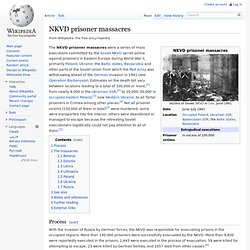
Atomic bombings of Hiroshima and Nagasaki. In August 1945, during the final stage of the Second World War, the United States dropped atomic bombs on the Japanese cities of Hiroshima and Nagasaki.

The two bombings, which killed at least 129,000 people, remain the only use of nuclear weapons for warfare in human history. Background Pacific War Main article: Pacific War As the Allied advance moved inexorably towards Japan, conditions became steadily worse for the Japanese people. Preparations to invade Japan. Jonestown. Coordinates: Jonestown Georgetown Kaituma Peoples Temple Agricultural Project ("Jonestown", Guyana)
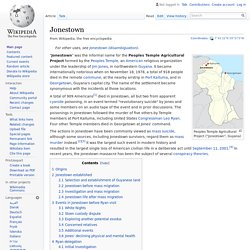
Korean War POWs detained in North Korea. "Korean War POWs (Prisoners of War) Detained in North Korea" (Korean: 국군포로) refer to the tens of thousands of South Korean soldiers who were captured by the North Korean and Chinese forces during the Korean War (1950–53) but were not returned during the prisoner exchanges under the 1953 Armistice Agreement.

Most are presumed dead but the South Korean government estimates some 560 South Korean POWs still survive in North Korea.[1][2] The unaccounted South Korean POW issue has been in dispute since the Armistice in 1953. North Korea continues to deny it holds these South Korean POWs.[3] Interest in this issue has been renewed since 1994, when Lt. Cho Chang-ho, a former South Korean soldier presumed to have been killed in the war, escaped from North Korea. As of 2008, 79 former South Korean soldiers have escaped from North Korea. Origins[edit] Nanking Massacre. An accurate estimation of the death toll in the massacre has not been achieved because most of the Japanese military records on the killings were deliberately destroyed or kept secret shortly after the surrender of Japan in 1945.

The International Military Tribunal of the Far East estimated in 1948 over 200,000 Chinese killed in the incident.[5] China's official estimate is more than 300,000 dead based on the evaluation of the Nanjing War Crimes Tribunal in 1947. The death toll has been actively contested among scholars since the 1980s, with typical estimates ranging from 40,000 to over 300,000.[6][7] Military situation. The Holocaust. The Holocaust (from the Greek ὁλόκαυστος holókaustos: hólos, "whole" and kaustós, "burnt")[2] also known as Shoah (Hebrew: השואה, HaShoah, "the catastrophe"; Yiddish: חורבן, Churben or Hurban, from the Hebrew for "destruction"), was the mass murder or genocide of approximately six million Jews during World War II, a programme of systematic state-sponsored murder by Nazi Germany, led by Adolf Hitler and the Nazi Party, throughout the German Reich and German-occupied territories.[3] Of the nine million Jews who had resided in Europe before the Holocaust, approximately two-thirds were killed.[4] Over one million Jewish children were killed in the Holocaust, as were approximately two million Jewish women and three million Jewish men.[5] A network of over 40,000 facilities in Germany and German-occupied territory were used to concentrate, hold, and kill Jews and other victims.[6]

Cuba. Cuba, officially the Republic of Cuba ( i/ˈkjuːbə/; Spanish: República de Cuba, pronounced: [reˈpuβlika ðe ˈkuβa] (
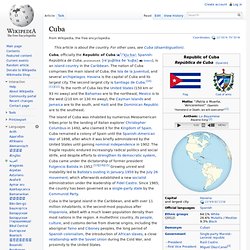
Black Holocaust in America.